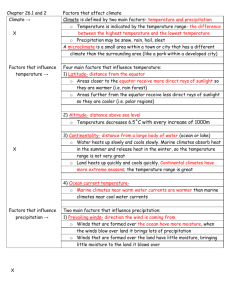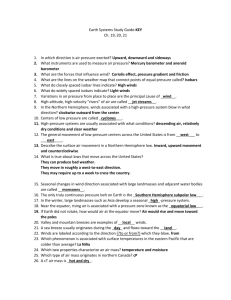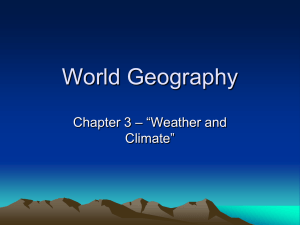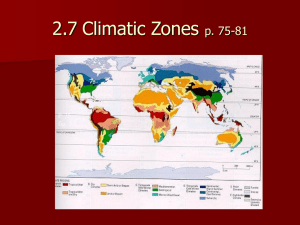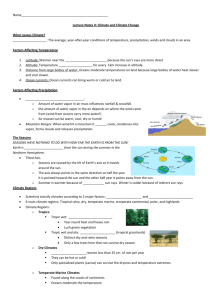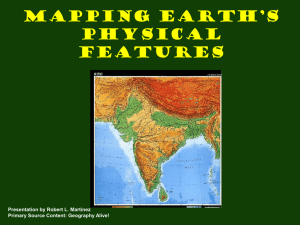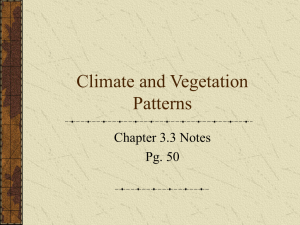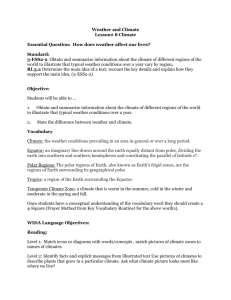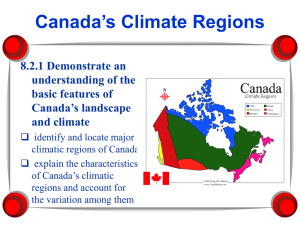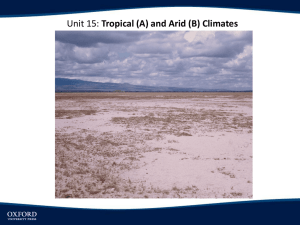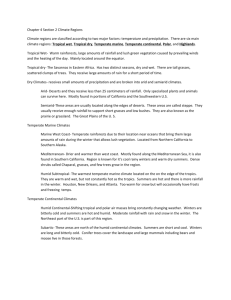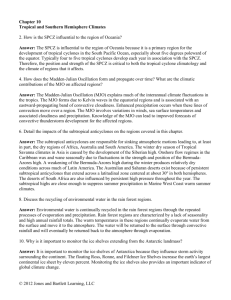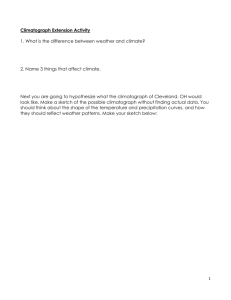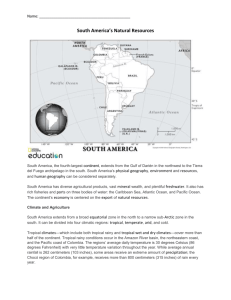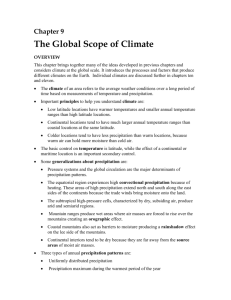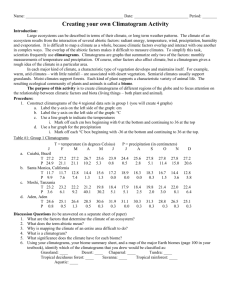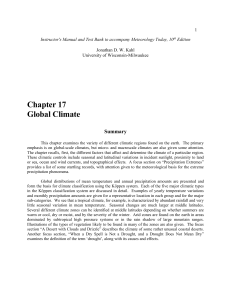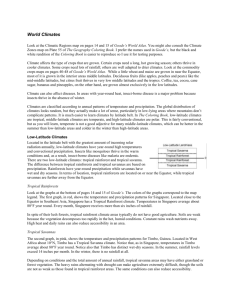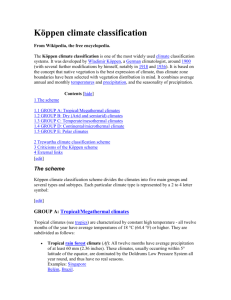Chapter 18 Climate and Climate Change C18S1 `What Causes
advertisement
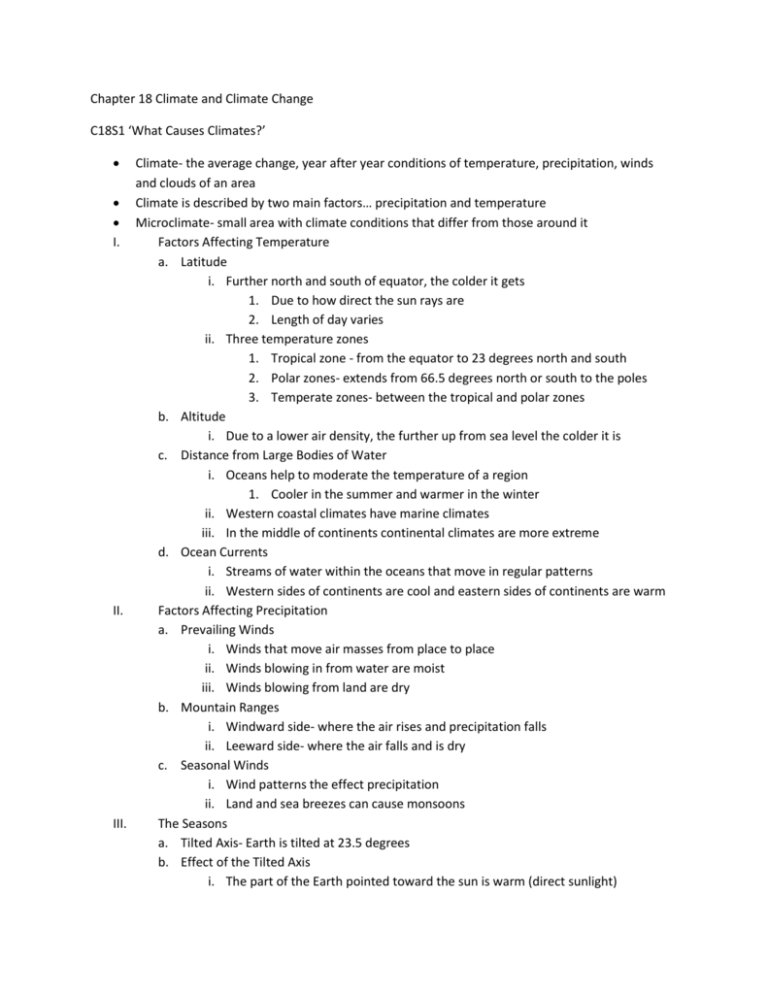
Chapter 18 Climate and Climate Change C18S1 ‘What Causes Climates?’ Climate- the average change, year after year conditions of temperature, precipitation, winds and clouds of an area Climate is described by two main factors… precipitation and temperature Microclimate- small area with climate conditions that differ from those around it I. Factors Affecting Temperature a. Latitude i. Further north and south of equator, the colder it gets 1. Due to how direct the sun rays are 2. Length of day varies ii. Three temperature zones 1. Tropical zone - from the equator to 23 degrees north and south 2. Polar zones- extends from 66.5 degrees north or south to the poles 3. Temperate zones- between the tropical and polar zones b. Altitude i. Due to a lower air density, the further up from sea level the colder it is c. Distance from Large Bodies of Water i. Oceans help to moderate the temperature of a region 1. Cooler in the summer and warmer in the winter ii. Western coastal climates have marine climates iii. In the middle of continents continental climates are more extreme d. Ocean Currents i. Streams of water within the oceans that move in regular patterns ii. Western sides of continents are cool and eastern sides of continents are warm II. Factors Affecting Precipitation a. Prevailing Winds i. Winds that move air masses from place to place ii. Winds blowing in from water are moist iii. Winds blowing from land are dry b. Mountain Ranges i. Windward side- where the air rises and precipitation falls ii. Leeward side- where the air falls and is dry c. Seasonal Winds i. Wind patterns the effect precipitation ii. Land and sea breezes can cause monsoons III. The Seasons a. Tilted Axis- Earth is tilted at 23.5 degrees b. Effect of the Tilted Axis i. The part of the Earth pointed toward the sun is warm (direct sunlight) ii. The part of the Earth pointed away from the sun is cooler (indirect sunlight) C18S2 ‘Climate Regions’ Climate is classified according to temperature and precipitation Six main climate regions: tropical rainy, dry, temperate marine, temperate continental, polar, and highlands I. Tropical Rainy Climates a. Tropical Wet i. Moisture usually comes from the ocean ii. Rain forests- forests will a lot of rain b. Tropical Wet and Dry i. Receive slightly less rain than tropical wet and have dry seasons ii. Tropical grasslands are called savanna II. Dry Climates ‘dry’ means the amount of precipitation that falls is less than the amount of water that could potentially evaporate a. Arid i. Deserts are arid regions on Earth ii. Areas which receive less than 25 cm of precipitation per year iii. Only certain plants can survive these climates b. Semiarid i. Located near the edge of deserts ii. Steppe is dry, but has a small amount of vegetation iii. Great Plains are the steppe region of the US III. Temperate Marine Climates a. Marine West Coast i. Coolest temperature are north of 40 degrees north and south ii. Extends from northern California to southern Alaska iii. Air rises due to the mountains causing rain near the west coast iv. A rain shadow occurs on the east side of mountains v. Thick forests are found here b. Mediterranean i. Coastal climate warmer and drier ii. Southern part of California iii. Mild with TWO seasons (winter and summer) c. Humid Subtropical i. Found along the edges of the tropics ii. The most southern parts of the US into the south Pacific and the Caribbean Sea IV. Temperate Continental Climates a. Humid Continental i. Not influenced by the oceans ii. Have extreme hot and cold weather b. Subarctic i. Climates that lie north of the humid continental regions ii. Short summers and long bitter winters Polar Climates a. Coldest climate region b. Ice Caps i. Formed on Greenland and in Antarctica ii. Average temperature is always below freezing c. Tundra i. Cool summers and long bitter winters ii. Area where the soil is always frozen- permafrost Highlands a. Temperature decreases has altitude increases b. Above a certain elevation- the tree-line –temperature are too low for tree growth V. VI. C18S3 ‘Long-term Changes in Climate’ I. Studying Climate Change a. Pollen i. On the bottom of lake plants that were in a region help let scientist tell what lived in a certain area b. Tree Rings i. Thickness of the rings 1. Helps telling the amount of rainfall in a region 2. Tells how long the growing season is II. Ice Ages Ice Ages = Glacial Episodes Transform landscape by carving giant grooves in rocks Fossil evidence suggests ice ages happen every 10,000 years Last one caused the formation of the Great Lakes III. Causes of Climate Change a. Earth’s Position i. How close or far the Earth is away from the sun ii. Tilt of the Earth changes b. Solar Energy i. Short-term changes due to sunspots 1. Darker, cooler areas on the sun 2. Satellite measurements show a slight increase in temperature c. Volcanic Activity i. The release of high amounts of gas and ash ii. The gas and ash filter out some of the incoming radiation, lowering temperatures d. Movement of Continents i. 225 million years ago there was a single continent known as Pangaea ii. Continents that were once in the polar regions are now near the equator C18S4 ‘Global Changes in the Atmosphere’ I. Short-Term Climate Change Changes in ocean current and winds can affect climates a. El Nino i. Warm-water event over the western Pacific ii. Occurs every 2 to 7 years iii. Changes weather patterns 1. Causes heavy rains or droughts (severe condition) 2. Lasts about 1 to 2 years b. La Nina i. Surface water in the eastern Pacific are colder than normal ii. Opposite of El Nino iii. Greater hurricane activity in the Atlantic II. Global Warming A lot of climate changes are due to human activities Gradual increase in global temperature- global warming a. The Greenhouse Hypothesis i. Process where the atmosphere traps heat ii. Heat can get in, but cannot get back out iii. Greenhouse gases- CO2, H2O, and methane b. Changing Levels of Carbon Dioxide i. Through bubble in Antarctica ice, CO2 stayed about the same ii. Burning of wood, coal, oil, and natural activities- human activity c. Climate Variation Hypothesis i. Natural variations in climate ii. Small changes in the sun’s energy that is released d. Possible Effects i. Evaporating water could cause exposed soil (possible ‘Dust Bowls’) ii. Increase the strength of hurricanes iii. Raising sea levels due to melting glaciers III. Ozone Depletion Too much ozone could cause a cool down, and too little could cause Global Warming a. Chlorofluorocarbons i. CFC’s- causes ozone depletion ii. UV radiation break down CFC’s and ultimately damage oxygen atoms b. Results of Ozone Depletion i. Less ozone means increase radiation to Earth ii. Laws were made to lessen the amount of CFC’s produced
